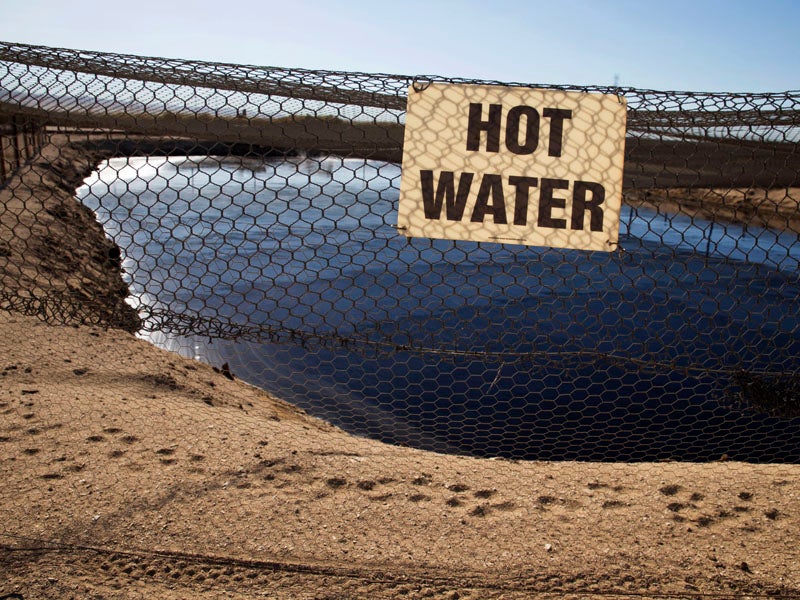California Offers Up Watered Down Drought Plan
Gov. Jerry Brown calls on Californians to take shorter showers, while giving Big Ag and the fossil fuel industry a free pass on conserving dwindling water supplies.

This page was published 10 years ago. Find the latest on Earthjustice’s work.
On April 1, 2015, responding to California’s deepening drought, Governor Jerry Brown issued an executive order placing limitations on such activities as watering golf courses, street medians, business campuses and cemeteries. The order mandates a statewide 25 percent reduction in use of potable urban water. Notably absent from the order was any required reduction in agricultural water use, although the agriculture industry consumes 80 percent of the state’s developed water supply.
“The executive order is a modest step in the right direction, but California’s water woes will not be solved by giving a pass to an industry that claims the lion’s share of the state’s water at subsidized rates and chooses to grow water-intensive crops in semi-arid regions.” – Earthjustice Staff Attorney, Trent Orr
Also conspicuously absent from the mandate were any restrictions on water use by the oil and gas industry, which utilized 70 million gallons of water for fracking last year. A state oil and gas supervisor assured Reuters that this was not all fresh water.
Speaking of the oil and gas industry, California’s groundwater contamination saga opened another chapter a few weeks ago with the announcement that state officials from California’s Division of Oil, Gas and Geothermal Resources (DOGGR) have directed oil companies to shut down 12 of their wastewater wells in the Central Valley. These sites are located within 500 feet of an underground well that provides drinking or agricultural water, but regulators believe that these sites present a direct contamination threat to the clean water.
Ten of the 12 wells are controlled by companies that have voluntarily relinquished their permits and closed the sites without objection. However, the remaining two sites required regulators to present cease-and-desist orders—one of these two sites has been illegally operating since 1977.
In addition to these 12 wells, there are currently 176 wells under immediate investigation (because they pose the greatest risk to high quality water), and 2,553 wells located in areas that the EPA never approved for wastewater injection. Regulators seem to have been asleep at the wheel for years.
How is this possible?
Bureaucratic miscommunication. Conflicting documentation between the EPA and DOGGR are to blame for this lack of regulation. At least, that’s the official story. The agencies’ mismatched checklists falsely indicated that some aquifers were safe for underground dumping, which led to the injection of wastewater for up to 38 years in areas that should have been off-limits. This lack of oversight allowed for the creation of those 176 waste disposal wells into aquifers whose water was once safe for drinking or irrigation.
But wait, there’s more.
This news broke less than a week after the Central Valley Regional Water Quality Control Board announced that oil producers are using more than 300 previously unidentified waste sites in Kern County, also located in California’s Central Valley, to dump their drilling and fracking wastewater—hundreds of these are unlined. The L.A. Times has an unsettling slideshow with aerial views of these pits.
Wastewater floating around in unlined pits is problematic because it is laden with chemicals left over from the fracking process, many of which are undisclosed to the public. Water forced out of the ground during the traditional oil drilling process is also dangerous because it is very salty and often contains benzene and other naturally occurring but still toxic compounds.
These waste sites came to light when the Water Quality Control Board compared its list of pit operations to a list compiled by the aforementioned Division of Oil, Gas and Geothermal Resources. The Control Board’s review identified 933 wastewater pits in Kern County, 578 of which are currently active. Over one-third of those that are active do not have permits to operate. Once again, poor communication between agencies has led to the potential for more groundwater contamination.
In a state suffering from the worst drought in 1,200 years, in a state where a NASA scientist has identified that its reservoirs only have about one year of water remaining, catching these regulatory errors are crucial and long over-due. These two stories of water mismanagement can only make you wonder: Is drilling oil that will only exacerbate climate change worth potentially contaminating the state’s dwindling supply of drinkable water? The answer may seem obvious, but when over half a million barrels of oil are being produced every day in California, I can guess what the oil industry’s answer would be.